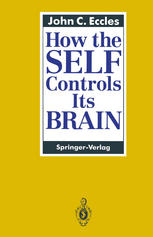How the Self Controls Its Brain
 | |
| Author | John Carew Eccles |
|---|---|
| Language | English |
| Subject | Psychology |
| Publisher | Springer-Verlag |
Publication date | 1994 |
| Publication place | Australia |
| Media type | |
| ISBN | 3-540-56290-7 |
| OCLC | 29634892 |
| 128/.2 20 | |
| LC Class | B105.M55 .E33 1994 |
How the Self Controls Its Brain[1] is a book by Sir John Eccles, proposing a theory of philosophical dualism, and offering a justification of how there can be mind-brain action without violating the principle of the conservation of energy. The model was developed jointly with the nuclear physicist Friedrich Beck in the period 1991–1992.[2][3][4]
Eccles called the fundamental neural units of the cerebral cortex "dendrons", which are cylindrical bundles of neurons arranged vertically in the six outer layers or laminae of the cortex, each cylinder being about 60 micrometres in diameter. Eccles proposed that each of the 40 million dendrons is linked with a mental unit, or "psychon", representing a unitary conscious experience. In willed actions and thought, psychons act on dendrons and, for a moment, increase the probability of the firing of selected neurons through quantum tunneling effect in synaptic exocytosis, while in perception the reverse process takes place.
Previous mention of the "psychon"
The earliest prior use of the word "psychon" with a similar meaning[5] of an "element of consciousness" is in the book "Concerning Fluctuating and Inaudible Sounds" by K. Dunlap in 1908.[6] The most popular prior use is in Robert Heinlein's short story Gulf, wherein a character refers to the fastest speed of thought possible as "one psychon per chronon".
See also
[edit]References
[edit]- ^ Eccles, John C. (1994). How the self controls its brain. Berlin: Springer-Verlag. ISBN 3-540-56290-7. OCLC 29634892.
- ^ Beck, Friedrich (2008). "My Odyssey with Sir John Eccles". NeuroQuantology. 6 (2): 161–163. doi:10.14704/nq.2008.6.2.170.
- ^ Beck, Friedrich; Eccles, John C. (1992). "Quantum aspects of brain activity and the role of consciousness" (PDF). Proc. Natl. Acad. Sci. U.S.A. 89 (23): 11357–11361. Bibcode:1992PNAS...8911357B. doi:10.1073/pnas.89.23.11357. PMC 50549. PMID 1333607. Archived (PDF) from the original on 2018-07-27.
- ^ Beck, Friedrich; Eccles, John C. (1998). "Quantum processes in the brain: A scientific basis of consciousness". Cognitive Studies: Bulletin of the Japanese Cognitive Science Society. 5 (2): 95–109.
- ^ "psychon". Google Books ngram viewer.
- ^ Dunlap, K. (1908). "Concerning Fluctuating and Inaudible Sounds".
